Quantum research has prompted high expectations and more than a dozen Nobel Prizes. Photonics is a key to the market’s future success, and it is particularly attractive when it comes to the miniaturization and integration of components.
ANDREAS THOSS, CONTRIBUTING EDITOR
The 2022 Nobel Prize in physics was awarded to three scientists, each with a record in quantum research. They were rewarded for discoveries they had made three decades ago, discoveries that paved the way for a new quantum revolution, or Quantum 2.0 as it is sometimes called.
Governments recognized the importance of these early developments and, combined, they committed almost $30 billion to fund research and development in domestic quantum initiatives, according to Qureca1.

But what is quantum technology, and what does it mean for photonics? The answer to the first question goes back about 100 years, when people such as Max Planck, Albert Einstein, and Louis de Broglie earned their Nobel Prizes with new ideas in physics that included the quantized nature of light, the photo-electric effect, and the wave-like character of electrons, respectively. Today, these ideas are seen as the first quantum revolution.
Indeed, Einstein’s paper “Zur Quantentheorie der Strahlung,” or “On the Quantum Theory of Radiation,” described the stimulated emission of radiation, which about 50 years later manifested as another quantum-
related invention, namely “light amplification by stimulated emission of radiation,” later abbreviated to “laser.”
With the laser, scientists had a tool to dig deeper into quantum mechanics, where there remained phenomena that scientists did not fully understand, such as entanglement, or “spooky action at a distance” as Einstein coined it. While Einstein used thought experiments to describe these concepts, more recent scientific experiments have confirmed the physical nature of quantum entanglement — leading us back to the awarding of the latest Nobel Prize in physics.
What’s in it for photonics?
Today, quantum technology most often refers to three applications: quantum communication, quantum computing, and quantum sensing.
Quantum communication refers to the use of quantum effects to achieve the safe transmission of data via an uncrackable encryption key. Once the key (a secret sequence of numbers) is transmitted,
the actual message is encrypted and
sent via regular communication
lines (Figure 1).
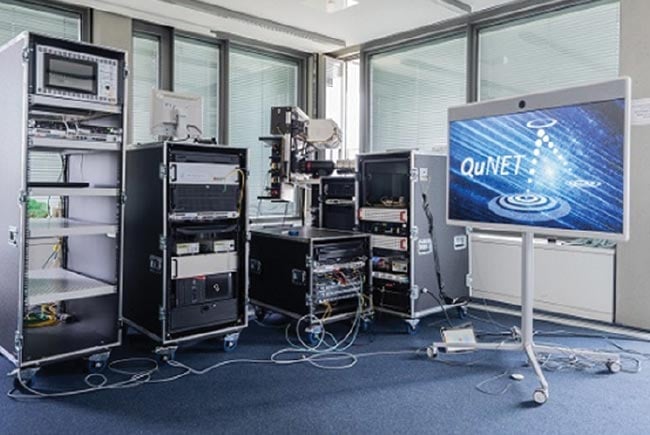
Figure 1. In 2021, two German ministries used the equipment from the QuNET project to establish a quantum secured video conference. The quantum key was exchanged via fiber and two free-space channels. Courtesy of Fraunhofer IOF.
Quantum encryption enables safe data transmission by using a laser to generate an entangled pair of photons that exhibit an identical quality or behavior despite being far apart. So, if a source sends such entangled photon pairs to receivers A and B, then an eavesdropper cannot interfere with either of the photons without being detected. If he picks up one entangled photon, it will not arrive at A or B. If the eavesdropper sends a similar photon from a different source, then it cannot be entangled.
While quantum encryption is inherently safe, it comes with a number of restrictions. The source must emit single photons; so, attenuation and noise are problems. Further, no amplification is possible because it is not possible to make a single photon stronger than it is. These restrictions limit transmission methods to free-space optics or direct fiber connections.
To generate safe code, or the so-called quantum key distribution, unentangled single photons are often good enough. Attenuating a light source to a level in which only single photons make it through the filter is already a method for generating quantum key distribution. In fact, quantum statistics govern the attenuated transmission of photons through the barrier. This principle has been used for the integrated quantum random number generator, which the Swiss company ID Quantique developed for Samsung’s Galaxy Quantum smartphones. Remarkably, this number generator is a 2.5- × 2.5-mm chipset in which an LED sends photons to a CMOS sensor.
The German initiative QuNET, which recently enabled a quantum-secured video conference between two German federal ministries, also used an attenuated light source to generate the quantum key distribution, according to Nino Walenta, a project team leader for photonic quantum technologies at the Fraunhofer Institute for Telecommunications, Heinrich Hertz Institute.
While such demonstrations of generating and transmitting quantum key distri-
bution via fiber and free-space optics are already on an advanced level, other sources for single photon generation are still a subject of research. Another potential source of generating single photons on demand leverages quantum dot-based techniques, for example, in which a laser pulse triggers the emission of one photon from a cooled solid-state system.
Creating entangled photon pairs is also a field of intense research. So far, many systems rely on spontaneous parametric downconversion, the inverse process to second-harmonic generation. A high-energy photon is split into two photons of lower energy and longer wavelength that are also inherently entangled.
A laser source coupled to a nonlinear crystal such as periodically poled lithium niobate makes a reasonably good source of entangled photons, as illustrated by the commercial modules now offered by
companies such as NTT Electronics. Some problems remain with this approach, however, such as a low rate of generated photons, the possible need for cooling of the single photon source, and the need for very efficient low-noise
detectors. But the technology offers a high potential for integration and miniaturization.
Bits vs. qubits vs. qumodes
Of all the quantum technologies, quantum computing clearly generates the most media buzz — so much so that many proponents fear it will lead to a “quantum winter,” in which huge expectations cannot possibly be fulfilled before disappointment spreads among funders and investors.
But, so far, the quantum computing field is dominated by success stories, led by IBM’s progress along its annually updated developmental road map. Venture capital is also flowing into the field and, unsurprisingly, big consulting companies are closely watching its development.
A quantum computer uses quantum phenomena such as superposition, interference, and entanglement to perform computing functions. Quantum phenomena are very different from the bits and bytes that we know, just as the approach of such phenomena to computation differs from that of established digital computers. For simplicity, analogies are sometimes drawn between a quantum computer’s qubit and conventional computing’s bit. But these analogies can be misleading. Where conventional bits are defined by a polar 1 or 0 state, qubits can occupy the states 1 and 0 plus their superpositions. The quantum effect is that all superpositions are possible, although measurement of a single qubit yields only a 1 or 0 state.
Quantum computers leverage various mechanics to encode and manipulate information2. The most famous quantum computer architecture is IBM’s system, which uses superconductors, or so-called transmons, as qubits. Three other quantum computer concepts shown in the table on this page — trapped ions, photonics, and cold atoms — make extensive use of lasers to encode information differently, using qumodes.
A qumode relies on a quantum mechanical harmonic oscillator — such as lightwaves — to achieve and access discrete quantum states. So, while a superconducting qubit has only two states, a qumode can access all of the discrete modes that a lightwave’s oscillations can accommodate. This is, in theory, an infinite number. Therefore, the state space for the photonic qubit can potentially carry much more information than that of a superconducting quantum computer.
The actual beauty of a photonic quantum computer lies in its inherent opportunity for integration and miniaturization. Fabrication of components can leverage conventional semiconductor processing. And thus many of the building blocks for these quantum computers have already been demonstrated within photonic integrated circuits. For example, small integrated ring resonators embedded on a chip can produce squeezed states of light, as needed, to produce qumodes (Figure 2).
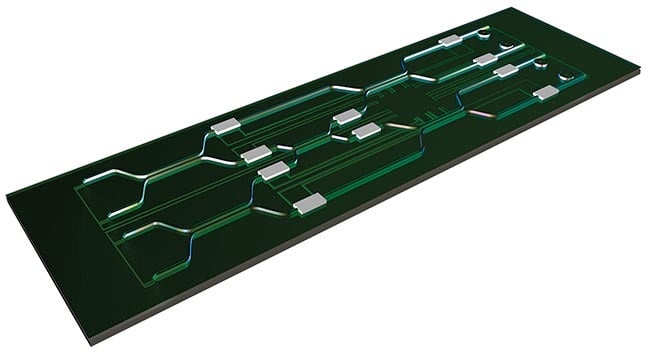
Figure 2. A compact photonic integrated circuit (PIC) that incorporates ring resonator sources (silver circles). Photonic approaches to quantum computing often lend themselves to the integration and miniaturization of components. Many building blocks for these computers have already been demonstrated, such as low-loss waveguides (green lines) and tunable retarders (silver rectangles). Courtesy of Q.ANT.
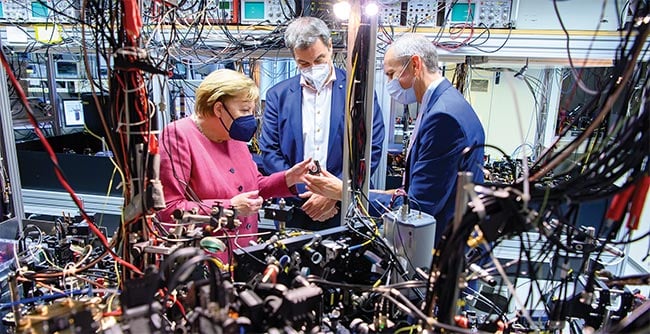
Figure 3. Integration and miniaturization are problematic for quantum computing components that are based on trapped ions and cold atoms, as illustrated by a setup shown to Germany’s then-Chancellor Angela Merkel and Bavarian Minister-President Markus Söder during a September 2021 tour of the Max Planck Institute of Quantum Optics. Courtesy of Max Planck Institute of Quantum Optics.
This level of integration is still far away for trapped ion and cold atom quantum computers, which rely on huge lab tables full of lasers and optical components (Figure 3) because it takes a lot of sophisticated lasers to trap, cool, and manipulate atoms and ions. Doppler cooling, for example, is a technique in which a laser beam is slightly red-tuned against the resonance frequency of an electron transition of an atom or ion. The atom or ion absorbs both the photon and its momentum, which effectively slows the particle down. This is the same idea behind laser traps in which counter propagating beams that intersect in three spatial dimensions drive an atom to the center of the intersection, where it is held at one exact position in space3 (Figure 4).
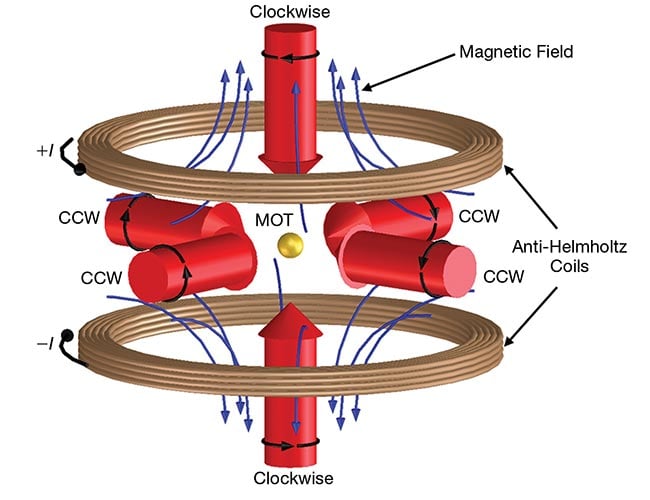
Figure 4. Counter-propagating laser beams and magnetic fields keep an ion in the center of a magneto-optical trap and cool it down. See Reference 3. CCW: counterclockwise; MOT: magneto-optical trap. Courtesy of CC BY 3.0.
This procedure requires stabilized single-frequency lasers, while different lasers might be needed for photoionization, state detection, Doppler cooling, repumping, and other steps.
Where are the markets?
TOPTICA Photonics AG has positioned itself to be a key supplier of lasers for cooling atoms and ions. The company’s portfolio of sources provides hundreds of different laser wavelengths targeting various quantum experiments — a market that TOPTICA’s founder and president, Wilhelm Kaenders, estimates to be worth about €150 million ($154 million).
As the number of units sold continues to rise rapidly, the pressure to lower unit price has also grown. But the biggest challenge is the demand for miniatur-
ization, Kaenders said. “The famous SWaP-C [size, weight, power, and cost] requirements of customers are getting louder and louder, and only if these criteria are implemented will the field that relies on these lasers have a future.”
Quantum computers leverage various mechanics to encode and manipulate information.

Though consulting companies see quantum technology eventually spawning a value chain worth many billions of
dollars, the current market generates revenue largely through the sale of components to researchers who develop quantum technologies. Actual quantum
computer sales remain limited to high-priced transactions involving single research systems, such as those recently delivered to Fraunhofer and the University of Tokyo.
Equipment for quantum communication is also slowly coming on the market already, with companies such as ID Quantique selling various types of quantum random number generators.
Quantum sensing appears to be where buyers can expect to see more commercial products soon. These products use quantum effects to measure physical quantities. A trapped ion — as shown in Figure 5, for example — can serve as a supersensitive gravimeter, measure magnetic fields, or simply act as the core of an optical clock.
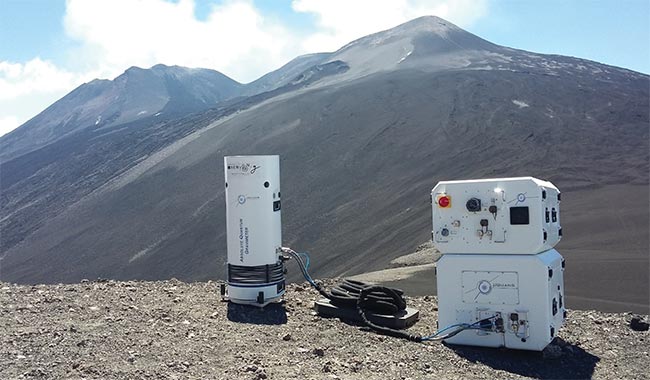
Figure 5. Quantum sensing is further along the path to commercialization compared to other quantum technologies. Devices using cold atoms, for example, can serve as supersensitive gravimeters, such as those designed by Muquans, now Exail. Courtesy of Exail.
Q.ANT, a spin-off from the TRUMPF Group, develops three different sorts of quantum sensors. The first is a particle sensor based on superposition states. The second is a magnetic field sensor based on nitrogen-vacancy centers in diamond. And the third is an atomic gyroscope based on rubidium atoms within vapor cells.
Miniaturization and integration have helped Q.ANT reduce its particle sensor to the size of a shoebox. “This size is acceptable for the customers we have in mind now,” said Q.ANT founder and CEO Michael Förtsch, adding that there is one rule: “The smaller the sensor, the bigger the market.” In other words, a shoebox-size sensor may be good for a thousand customers in industry, but a sensor targeting consumer markets might need to be the size of a matchbox or smaller. This rule of thumb is apparent in the lidar market, which suggests that the rule is valid for quantum sensor applications.
Currently, Q.ANT is working with commercial collaborators to test its sensors in applications, such as measuring the grain size of coffee or laundry detergent.
Larger, more recognized industry players are also engaging in the development of quantum technology. But, for them, the key question is how to connect existing product lines to capitalize on the emerging quantum market. Chipmaker Infineon, for example, is contributing its expertise and manufacturing capacity to support the development of quantum computing and sensing components in several partner projects.
The market for quantum technology is emerging as quickly as the technical
solutions are themselves evolving. Miniaturization and greater integration of photonic components will be key to fostering wider commercialization of quantum technologies such as sensors and telecom equipment. Integrated photonics will also be critical to scaling up quantum computers.
References
1. Qureca (Mar. 10, 2022). Overview on quantum initiatives worldwide — update 2022, www.qureca.com/overview-on-quantum-initiatives-worldwide-update-2022.
2. B. Langione and T. Gourévitch (2021). What happens when ‘if’ turns to ‘when’ in quantum computing? Exhibit 6: the current state of progress of the leading hardware technologies, www.bcg.com/de-de/publications/2021/building-quantum-advantage.
3. J.J. McClelland et al. (2015). Bright focused ion beam sources based on laser-cooled atoms. Appl Phy Rev, Vol. 3, www.doi.org/10.1063/1.4944491.